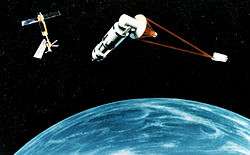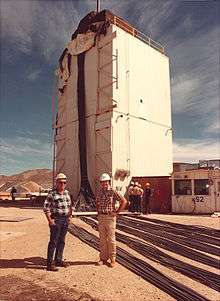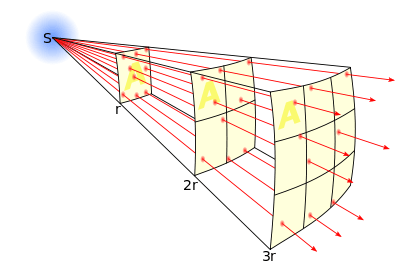Project Excalibur
Project Excalibur was a United States government nuclear weapons research program to develop a nuclear pumped x-ray laser as a directed energy weapon for ballistic missile defence.[1] It became part of the Strategic Defense Initiative (SDI).[1] Conceived and developed by nuclear scientists Edward Teller, George Chapline, Jr. Peter L. Hagelstein and Lowell Wood the concept involved packing large numbers of expendable soft x-ray lasers around a nuclear device. When the device detonated, it would fire soft x-ray laser beams in many directions.[2] The goal was to aim these beams to shoot down enemy nuclear missiles near the end of, and after the missiles boost phase stage of flight. The kill mechanism of the X-ray laser was ablative laser propulsion shock;[2][3] that is, the x-rays would heat the surface of the missile, causing it to vaporize explosively, destroying it or knocking it off course.
Design impetus

The Excalibur project was proposed as a solution to the problems of using more conventional satellite based optical lasers to shoot down missiles. This original proposal was to place many infrared or x-ray laser satellites in orbit - as there needed to be at least one between the U.S. and its enemies when a massive launch of intercontinental ballistic missiles (ICBMs) occurred. With the Soviet Union viewed as the primary foe technologically able to accomplish such a massive simultaneous launch. If a large nearly simultaneous launch of ICBMs occurred, in a saturation attack, the single beam and power limited Space Based Laser(SBL)s would not have enough time to destroy them all, since each satellite would only be capable of firing upon them one at a time. Moreover, it was felt that the large optics of the SBLs could not be re-positioned to point from one enemy missile to the next quickly enough. A considerable amount of research went into rapidly re-targeting the Space Based Laser concept so that many missiles could be destroyed in a short space of time to deal with the massive saturation attack. However, this approach remained out of reach, giving rise to the Excalibur approach, which was viewed as something of a desperate approach even by those who worked on the project.
Mechanism and capabilities
Limited accounts in the unclassified press indicate that the Excalibur device consisted of a small nuclear explosive device surrounded by multiple rods made of a material that served as an x-ray gain medium, releasing x-rays when "pumped" by incident photons.[2] Each rod would function as a separate x-ray laser. The x-ray laser would be optically pumped by the extremely high density of high energy photons that appear in the first nanoseconds of a nuclear detonation. The pumped medium would emit a pulse of coherent x-rays, in the direction of the long axis of the rod.[2] Unlike optical lasers, in which the light is reflected by mirrors at the ends and makes multiple passes through the gain medium, in the x-ray laser the x-ray pulse is generated in a single pass through the rod.[2] The calculations showed that the extremely high gain and high energy pulse from the lasers would occur before the detonation destroyed the lasers and the rest of the satellite. If large numbers of gain media rods were used, each pre-aligned to point at a missile, then a large number of missiles could be destroyed in one fell swoop.[2]
As Teller put it in a letter to Paul Nitze, "A single X-ray laser module the size of an executive desk... could potentially shoot down the entire Soviet land-based missile force..."[5]
Testing & results

The US project was the result of a 1977 development by George Chapline, Jr. of Lawrence Livermore's "O-Group". Livermore had been working on X-ray lasers for some time, but Chapline found a new solution that used the massive release of X-rays from a nuclear warhead as the source of light for a small baseball-bat sized lasing crystal in the form of a metal rod.[6] The concept was first tried out in the 1978 underground nuclear test "Diablo Hawk" but had failed. Peter Hagelstein, new to O Group, set about creating computer simulations of the system in order to understand why. At first he demonstrated that Chapline's original calculations were simply wrong and the Diablo Hawk system could not possibly work. But as he continued his efforts, he found that using heavier metals appeared to make a machine that would work. Through 1979 a new test was planned to take advantage of his work.[7] The follow-up test in November 1980s "Dauphin" appeared to be a success, and plans were made for a major series of experiments in the early 1980s under "Excalibur".[8]
Ten known tests of nuclear-pumped x-ray lasers were conducted between 1978 and 1988.[9]
'Pop up' basing
Since satellite basing of nuclear explosive devices would violate the Outer Space Treaty which prohibits nuclear weapons in space, a later proposal would have based the Excalibur packages/modules on missiles in Alaska, which on warning of a nuclear strike would have "popped up" into space in the path of the approaching ICBMs.[10][11] In an effort to be closer still to the point of launch, another proposal suggested basing the missiles on SLBMs[12] in the Sea of Okhotsk and the Kara Sea.
Termination
Following the end of the Cold War, the project was determined to be out of reach of current technology and was formally abandoned in 1992. Research was redirected back to the likes of the space based laser satellite (SBL) concept, using SDI chemical lasers and kinetic energy weapons under the Strategic Defense Initiative such as the Lightweight Exo-Atmospheric Projectile presently (2014) still in use on the Aegis SM-3 missile.
Conceptual predecessors

An earlier antiballistic missile system that also employed radiation (x-rays) was the Spartan missile, part of the Safeguard ABM system that was very briefly deployed 1975-1978 before treaties eliminated it.[13] This was designed to intercept the enemy warhead outside the atmosphere and destroy it with radiation from a 5 megaton W71 enhanced radiation nuclear warhead. A similar mechanism of destruction is used in the Soviet Union/Russian counterpart to Spartan, the 1980s "ABM-4 Gorgon" missile of the A-135 anti-ballistic missile system, which remains active.[14] Because the radiation from a nuclear explosion expands in all directions decreasing with the inverse-square of distance, the kill range of these weapons was limited. The x-ray laser in contrast uses a smaller amount of energy but directs it precisely in one direction, and thus is able to kill multiple warheads at a greater range.
Countermeasures
In the 1986 Operation Charioteer series of underground nuclear testing, test shot "Mighty Oak" was designed to expose a US Trident (missile) warhead to X-ray flux to observe its damage response.[15] The choice of shot name, "Mighty Oak", is likely a reference to the popular fable, The Oak and the Reed, in which; 'A reed before the wind lives on, while mighty oaks do fall'/'Better bend than break'. Alluding to the best way to reduce "wind" damage, which in this case is countermeasures against the ablation generated shock wave. By utilizing warhead components that like the reed, in the fable, survive or can attenuate shock waves, such as ultra low density aerogels. With these aerogel fillers being components of the trident missiles W76 warhead, having the code-name "FOGBANK".
Evidence supporting the idea that warheads could be "hardened" against the effects of ablation generated shock waves, exists in the two lethal ranges stated for the Excalibur concepts predecessor, the W71 warhead, which had a lethal exo-atmospheric radius of 12 miles (19 km) against warheads without countermeasures against soft x-ray generated shock waves, but a range as little as 4 miles (6.4 km) against warheads that did.[16]
Non-nuclear tests to ascertain the capabilities of the fogbank material are still ongoing, with silver acetylide-silver nitrate composition (SASN) - a chemical explosive chosen for testing due to its unusual chemical property of not forming any gaseous products upon detonation, but instead releasing heat only. SA is deposited onto the outside of the W76s re-entry vehicle(RV) and detonated all at once, using an intense flash of light. The resulting uniform blast of moderate intensity approximates the shock response that the US warhead will have when it encounters the Russian Gorgon anti-ballistic missile. A "cold x-ray blowoff impulse generated by an exo-atmospheric hostile nuclear encounter".[17][18]
Drawings
A number of artist's impressions of the Excalibur device were made.[19][20]
Cultural influence
Excalibur's main influence has been its appearances in science fiction, most notably in David Weber's Honorverse military science fiction book series.
Related Excalibur program
Unlike Project Excalibur, the "Excalibur Program" is a non-nuclear optical phased array, high energy laser system funded by DARPA. While the nuclear powered Project Excalibur was intended for space interceptions, the Excalibur program is primarily intended for the atmospheric environment and does not emit x-rays. As of 2014 it reportedly achieved a number of design goals, intent on solving the problem of atmospheric attenuation/blooming, by making sub-millisecond adjustments to each laser's power and frequency in the array.[21][22] This is the laser equivalent of adaptive optics, which likewise makes adjustments to the shape of telescope mirrors to eliminate the interference caused by the atmosphere.
See also
References
- 1 2 Waldman, Harry (1988). The Dictionary of SDI. New York: Rowman & Littlefield. pp. 58, 157–158. ISBN 0842022953.
- 1 2 3 4 5 6 Carter, Ashton P. (April 1984). "Directed Energy Missile Defence in Space" (PDF). Massachusetts Institute of Technology: 24–28. Retrieved 8 October 2013. under contract for the US Office of Technology Assessment
- ↑ RESTRICTED DATA DECLASSIFICATION DECISIONS, 1946 TO THE PRESENT (RDD-7), January 1, 2001 "The fact that a kill mechanism for an x-ray laser is ablative shock".
- ↑ "Space Based Laser. FAS.".
- ↑ "Teller's telltale letters", Bulletin of the Atomic Scientists, November 1988
- ↑ Jeff Hecht, "The strange story being the X-ray laser", New Scientist, October 15, 1981, pg. 166
- ↑ Peter Goodchild, "Edward Teller, the real Dr. Strangelove", Harvard University Press, 2004, pg 333–345
- ↑ Frances FitzGerald, "Way Out There in the Blue: Reagan, Star Wars and the End of the Cold War", pg. 129
- ↑ Schwartz, Stephen I. (1998). Atomic Audit: The Costs and Consequences of US Nuclear Weapons since 1940. Brookings Institution. pp. 81–82. ISBN 0-8157-7774-4.
- ↑ https://www.fas.org/spp/military/program/lexicon.htm Pop-up A mode of deployment for a weapon or sensor system that is based on the ground or on ships at sea and is launched or popped-up into space where it operates when needed. Frequently used in reference to the Excalibur X-ray laser that would be launched from submarines.
- ↑ The Star Wars Enigma: Behind the Scenes of the Cold War Race for Missile Defense By Nigel Hey
- ↑ https://www.fas.org/spp/military/program/lexicon.htm Pop-up A mode of deployment for a weapon or sensor system that is based on the ground or on ships at sea and is launched or popped-up into space where it operates when needed. Frequently used in reference to the Excalibur X-ray laser that would be launched from submarines.
- ↑ "W-71 warhead information at Globalsecurity.org "...in 1972, the United States and the Soviet Union signed the ABM Treaty. However, protection against ballistic missile attack remained a goal and technological challenge for Laboratory researchers and was pursued with renewed vigor after President Reagan launched the Strategic Defense Initiative. Nuclear directed- energy weapons were pursued at Livermore, including experimental demonstration of x- ray lasing at the Nevada Test Site. "".
- ↑ O'Connor, Sean (2012). "Russian/Soviet Anti-Ballistic Missile Systems". Air Power Australia. Retrieved 2012-04-30.
- ↑ A Historical Evaluation of the U12t Tunnel, Nevada Test Site, Nye County, Nevada, Volume 6 of 6. OSTI 1010606
- ↑ M. Todd Bennett (ed), "National Security Policy, 1969–1972", 2011, p. 41, 54.
- ↑ "Sourcebook on the Light-Initiated High-Explosives Facility Sandia National Laboratories, Albuquerque, New Mexico. Search for SDI Laser" (PDF).
- ↑ "Page 1 Shock and Vibration 15 (2008) 619–62, Lessons learned in applying accelerometers to nuclear effects testing" (PDF).
- ↑ http://www.sciencephoto.com/media/337464/enlarge
- ↑ http://www.projectrho.com/public_html/rocket/spacegunconvent.php
- ↑ Successful EXCALIBUR Test Brings DARPA Closer to Compact High Energy Lasers
- ↑ DARPA’s prototype Excalibur laser successfully zaps target 7 kilometers away, 2014
Further reading
- American Physical Society. Study Group on Science and Technology of Directed Energy Weapons. Science and Technology of Directed Energy Weapons/ Report of the American Physical Society Study Group.. New York: American Physical Society, 1987.
- Anti-Satellite Weapons, Countermeasures and Arms Control. Washington, D.C.: Office of Technology Assessment, U.S. Congress, September 1985. OTA-ISC-285.
- Ballistic Missile Defense Technologies. Washington, D.C.: Office of Technology Assessment, U.S. Congress, September 1985. OTA-ISC-254.
- Bloembergen, N., C. K. Patel, P. Avizonis, R. G. Clem, A. Hertzberg, T. H. Johnson, T. Marshall, R. B. Miller, W. E. Morrow, E. E. Salpeter, A. M. Sessler, J. D. Sullivan, J. C. Wyant, A. Yariv, R. N. Zare, A. J. Glass, L. C. Hebel, G. E. Pake, M. M. May, W. K. Panofsky, A. L. Schawlow, C. H. Townes, and H. York APS Study Group Participants, APS Council Review Committee. "Report to The American Physical Society of the Study Group on Science and Technology of Directed Energy Weapons". Reviews of Modern Physics 59, no. 3 (July 1987): S1–S201.
- Carter, Ashton B. Directed Energy Missile Defense in Space. Washington, D.C.: Office of Technology Assessment, U.S. Congress, April 1984. OTA-BP-ISC-26.
- Goodchild, Peter. "Meet the real Dr Strangelove". The Guardian, April 1, 2004. Accessed 8 October 2008.
- Nuclear Strategy and World Security: Annals of Pugwash 1984 by Joseph Rotblat, Sven Hellman. pp 115
- Hecht, Jeff. Beam Weapons: The Next Arms Race. New York: Plenum Press, 1984. ISBN 0-306-41546-1.
- Perlman, David. "The Dilemmas of Decision-Making from AIDS to SDI". In Golden, William T., Science and Technology Advice to the President, Congress, and Judiciary, 2nd ed. New Brunswick, U.S.A.: Transaction Publishers, 1995, pp. 255–261. ISBN 1-56000-829-6. Accessed 8 October 2008.
- Ritson, David M. "The Nuclear-Pumped X-ray Laser, a Weapon for the Twenty-first Century". Nature 328, 487–490 (7 August 1987). doi:10.1038/328487a0.
- Thomsen, Dietrich E. "Strategic defense of X-ray initiative - X-ray laser research". Science News, December 14, 1985. Accessed 8 October 2008.